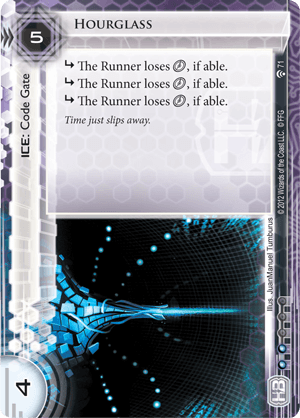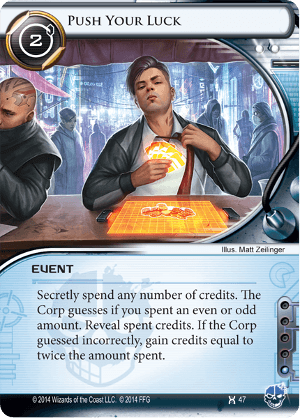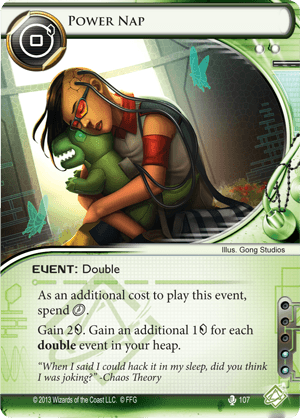Running against CI7
A lot of runners don’t really have any practice against CI7. This typically means they don’t know any of the tricks to beat it, and CI7 often does a lot better than it really should. In the previous article, we talked about how to setup as a CI7 corp. This was the last of the articles on how to play CI7. This article is focused on the other side, running against CI7.
The clock
 |
| No, don't play hourglass in your decks. I'm just making a thematic point. |
For example:
Base clock - 11 credits and 6 cards (AD, PS, SFMM, JH, JH/EC, X1)
Clot lock - 15 credits and 8 cards (AD, PS, SFMM, JH, JH/EC, X1, X2, X3)
Clot + CC lock - 18 credits and 9 cards (AD, PS, SFMM, JH, JH/EC, X1, X2, X3, X4)
When the clock is still active, you are able to run as aggressively as possible, getting as many accesses as possible. As soon as the clock has reached its point, it is usually ideal to stop.
Ice checking:
In the CI7 deck I posted, most of the subroutines are end the run. The only exception to this is Ichi 1.0. That said, it is not safe to assume that every CI7 deck is the same as I've described. Cards like rototurret are common, so you should aim to have an answer to sentries if you can't afford to lose an icebreaker.
CI7 typically has low ice compared to any typical glacier deck, and if your runner is prepared for glacier ice, he should be able to play against CI7 and get many early accesses. Typical running rules apply during this period of the game.
The clock reaches 0
This is a list of strategies the runner can take when it thinks CI7 has closed its clock (usually by reaching the credit threshold).
Balls to the wall:
 |
| Just keep running |
In this running style, you just run as often as you can, not caring that CI7 can potentially score out on you. CI7 is a combo deck, so they might not have a key card early-mid game, and in the meantime, their relatively low ice-count isn’t super difficult to break through. If you keep accessing, you may win before they can combo. Unskilled players usually default to this style, and sometimes they win games this way that a skilled player would have lost, because CI7 doesn't have the cards needed.
This may seem like a naive way to beat CI7, but if you are running HQ and R&D a lot and they are not comboing out, you might be able to get a fair idea of what cards they have and which they are missing. This gives you a rare opportunity to accurately measure the clock as a runner and find out when it has truly ended (by seeing the right card in R&D, for example). If you have this figured out, you can keep running until you accurately know when it has ended.
The power turn:
 |
| Take your time and get ready |
When the clock runs out, stop running. They can't combo without playing power shutdown, or drawing their entire deck, so by stopping running you are forcing them to start drawing a large quantity of cards. Hopefully by this stage you have a few agendas from the early-game aggression, and you can start saving up for the power turn. Your aim here is to prepare for a single turn where you will run, gaining enough agenda points to end the game. Your best bet is to set up a large amount of multi-access, such as double or triple Legwork/TME, as well as other win-enabling cards, perhaps Freedom Through Equality. If you already managed to acquire 1-2 agendas while the clock was still running, this may not be too difficult.
It is worth noting that this clock is not indefinite. If the CI7 player has been given enough time to setup, they can be in a very strong position where they might force your power turn early. If they can afford for you to take 2 agendas, then they might place a naked EC on the table and advance it once (or not advance it and use BL next turn). If you ignore this, you're in a significantly worse position for the combo-turn, but if you run it, they can start their combo without you.
Extend the clock:
 |
| Get some time back |
You know all those cards that were described in the previous two articles, and how CI7 has a way around all of them? That may be true, but playing them still extends the clock, giving you more time to access cards.
Pack some setup-hate:
If you have hate, you can extend the amount of time you can safely run, before having to wait for the power turn. Sometimes, you can even set CI7 back sufficiently that they can't even recover. Some examples of strategies here: If you Vamp the Corp down to 0, then you know that even if they Reuse, they can’t score next turn, so it is safe to keep running that turn (NOTE: If they have double BL then this doesn't work. Play your vamps early if possible). If you play Hades Shard, then you know that until they’ve drawn most of their deck, it is safe for you to keep running. If you have Archives Interface or Salsette Slums, you may just be able to win the game by making a few targeted ‘snipes' of key pieces.
Pack some combo-hate:
Combo-hate is actually similar to setup-hate. Typically, there are very few pieces of combo-hate that CI7 can’t trick their way through. When you add combo-hate, you are typically doing two things. The first thing you are doing is testing the CI7 player. Some of these combos are tricky to work out, and even I would have trouble doing them in real-life, as opposed to just writing them on a piece of paper and backtracking when needed. If you have enough hate, particularly of the more obscure variety, the Corp player might just screw up their combo, despite having the required pieces for pulling it off. This should not be relied upon as a runner, however, as a skilled player will just work their way through it. The other thing this does is slow down the clock so they have to work harder to get the required pieces in time. In my experience, combo-hate is typically worse at slowing down the corp than setup-hate, but requires less runner-skill to pull off. The best way to beat CI7 is some combination of both approaches.
Absolute hard counters to CI7
| I told you man! |
There are some strategies that CI7 is completely unable to recover from. If you vamp them to 0 credits, let them reuse and then immediately vamp them to 0 the next turn, then it is unlikely they will have enough spare cards in hand to reuse a second time (even if they kept the AM in hand) (Again NOTE: They can still combo through this if they have 2 BL in hand as well as reuse). This means they will have to discard their entire hand and you can probably hit archives for the win. If you have a third vamp you can absolutely guarantee this. Pulling this off requires a very large sum of credits, probably around 50-60.
Another approach is to spam employee strike as many times as possible. With cards like Deja Vu or Same Old Thing, you can replace it as many times as they counter it. Their only options here are to FA agendas, use ELP, or use AM into ELP. They are unable to keep this up indefinitely and will be put in a position of having to discard to 5 cards, making the game unwinnable for them.
In terms of preventing the combo, there are a few cards that are almost impossible for CI7 to beat. To absolutely stop CI7 from pulling off the combo, you will need a combination of combo-hate cards, such as triple of councilman, triple of saccon (and clot + CC), or eden shard with something like double councilman. Unfortunately, playing these cards in combination completely waters down your runner deck against any non-CI7 matchup. Therefore cards to prevent the CI7 combo should be considered from the point of view of their effectiveness outside of the CI7 matchup also. By this measure, the most effective card that hard-counters CI7 is Noise.
Noise + paid ability windows (Street Peddler is almost always a 3x include with him) makes the combo exceptionally difficult. The example in Part 2 unfortunately shows that he can combo through this with a perfect hand, by saving clicks from having to RO(AD) or interns any cards, the corp can create some extra redundancy in the combo and pass through it. Noise has the ability to mill cards just by installing viruses, and in a typical game he naturally mills away important cards. If Noise hits a single one of the crucial installables (such as a JH) or a single AD, then the example in Part 2 becomes impossible. Noise's combination of strong combo-hate combined with reasonable setup-hate makes him the worst match-up for a CI7 player. Sadly, with the latest MWL release, Noise has a lot of trouble packing enough cards to be effective. This document was written shortly after MWL1.2 was released, so I am only speculating here, but I think Noise will be seeing a lot less play. His current pawnshop influence build has been cut by at least 7 influence, and you can only cut this by dropping the Levy, and either 2 pawnshops or 1 pawnshop and some caches. Because of this, CI7 will be a more popular and effective deck.
Noise + paid ability windows (Street Peddler is almost always a 3x include with him) makes the combo exceptionally difficult. The example in Part 2 unfortunately shows that he can combo through this with a perfect hand, by saving clicks from having to RO(AD) or interns any cards, the corp can create some extra redundancy in the combo and pass through it. Noise has the ability to mill cards just by installing viruses, and in a typical game he naturally mills away important cards. If Noise hits a single one of the crucial installables (such as a JH) or a single AD, then the example in Part 2 becomes impossible. Noise's combination of strong combo-hate combined with reasonable setup-hate makes him the worst match-up for a CI7 player. Sadly, with the latest MWL release, Noise has a lot of trouble packing enough cards to be effective. This document was written shortly after MWL1.2 was released, so I am only speculating here, but I think Noise will be seeing a lot less play. His current pawnshop influence build has been cut by at least 7 influence, and you can only cut this by dropping the Levy, and either 2 pawnshops or 1 pawnshop and some caches. Because of this, CI7 will be a more popular and effective deck.
Salsette Slums will destroy CI7 if the runner manages to hit two JH, but guaranteeing such a hits are difficult, and searching for it might give CI7 the turn it needs to win. Hitting one JH is a pain, but the corp can aim to win in 2 piles instead of the usual 3. Archives interface is similar, in that only if you hit enough pieces is it an absolute hard-counter to CI7. Hitting the right pieces might be a lot easier if they are naturally getting put into archives anyway, however a smart CI7 player will stop discarding once they see Archives Interface in play, so it is best as a surprise action.
A well timed The Black File, if used during a paid ability window (via Street Peddler or Artist Colony), will also destroy CI7. Just wait until they're 1 click away from scoring the last agenda and bring it out, and without any cards in R&D they will lose the game from decking. Most CI7 decks don't run any cards to counter this (such as foxfire), so it is likely a guaranteed kill-shot if you can pull it off.
A well timed The Black File, if used during a paid ability window (via Street Peddler or Artist Colony), will also destroy CI7. Just wait until they're 1 click away from scoring the last agenda and bring it out, and without any cards in R&D they will lose the game from decking. Most CI7 decks don't run any cards to counter this (such as foxfire), so it is likely a guaranteed kill-shot if you can pull it off.
Conclusion
CI7 has potential to be an incredibly fun match-up for both runner and corp. It may be tempting after reading all these articles to pack in every piece of hate you can imagine and prevent them from being able to perform the combo ever, however the most fun games (for both sides) are when the runner is packing a small amount of hate and both sides are playing a skilled back and forth of trying to setup fast or getting hated down. Sometimes CI7 will just happen to get all the pieces in hand super fast, but this is no different to how NEH would sometimes score 2 Astroscript Pilot Programs by turn 4, and the average game goes a lot longer and has a lot of potential for fun interactions.
With this article complete, it covers the majority of the information in this article series. The next article will be a concluding statement, which will cover some alternate deck-building choices as well as a general list of heuristics for what to do against certain situations as the corp.

Some people are really obsessed with games and it is really visible by your enthusiasm. I really like how you have listed down all the rules. Good luck for your future.
ReplyDelete